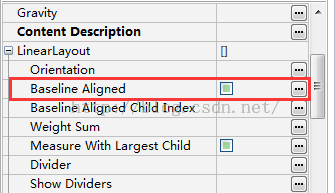此问题来自一个网友的提问 http://ask.csdn.net/questions/206909#answer_140060
看下面的布局文件
<LinearLayout xmlns:android="http://schemas.android.com/apk/res/android" xmlns:tools="http://schemas.android.com/tools" android:layout_width="match_parent" android:layout_height="match_parent" tools:context=".MainActivity" > <TextView android:layout_width="150dp" android:layout_height="60dp" android:background="#8f8f8f" android:text="第一个" /> <TextView android:layout_width="100dp" android:layout_height="60dp" android:background="#8f00" android:gravity="center" android:text="第二个" android:textSize="20dp" /> </LinearLayout>
这个布局非常简单,LinearLayout里面嵌套了两个TextView组件,他们的高度一样,宽度不一样,期望结果是,两个TextView顶端是对齐的,高度一样,大小,文字对齐方式可以任意设置。这个布局实际渲染出来的结构是这样

完全错位了,只要你设置不同的字号,Gravity,都会引起位置错乱,究其原因,就是LinearLayout的BaselineAligned属性惹的祸,看一下LinearLayout的默认属性

很多时候,我们都被那个绿色框框给迷惑了,对于boolean属性,这个状态不一定是false,它只代表与系统设定的默认值一致,那么系统对这个变量是怎样设置的呢,看看LinearLayout源码( 位置:/sdks/sources/android-19/android/widget )
/** * Whether the children of this layout are baseline aligned. Only applicable * if {@link #mOrientation} is horizontal. */ @ViewDebug.ExportedProperty(category = "layout") private boolean mBaselineAligned = true; 看到了吧,默认值就是true,而且告诉我们只对 水平布局 有效。那么这个属性对布局产生了怎样的影响呢,继续看LinearLayout布局时都干了啥:
@Override protected void onLayout(boolean changed, int l, int t, int r, int b) { if (mOrientation == VERTICAL) { layoutVertical(l, t, r, b); } else { layoutHorizontal(l, t, r, b); } } 横向布局时,会调用layoutHorizontal,下面摘取一段代码
if (child == null) { childLeft += measureNullChild(childIndex); } else if (child.getVisibility() != GONE) { final int childWidth = child.getMeasuredWidth(); final int childHeight = child.getMeasuredHeight(); int childBaseline = -1; final LinearLayout.LayoutParams lp = (LinearLayout.LayoutParams) child.getLayoutParams(); if (baselineAligned && lp.height != LayoutParams.MATCH_PARENT) { childBaseline = child.getBaseline(); } int gravity = lp.gravity; if (gravity < 0) { gravity = minorGravity; } switch (gravity & Gravity.VERTICAL_GRAVITY_MASK) { case Gravity.TOP: childTop = paddingTop + lp.topMargin; if (childBaseline != -1) { childTop += maxAscent[INDEX_TOP] - childBaseline; } break; case Gravity.CENTER_VERTICAL: // Removed support for baseline alignment when layout_gravity or // gravity == center_vertical. See bug #1038483. // Keep the code around if we need to re-enable this feature // if (childBaseline != -1) { // // Align baselines vertically only if the child is smaller than us // if (childSpace - childHeight > 0) { // childTop = paddingTop + (childSpace / 2) - childBaseline; // } else { // childTop = paddingTop + (childSpace - childHeight) / 2; // } // } else { childTop = paddingTop + ((childSpace - childHeight) / 2) + lp.topMargin - lp.bottomMargin; break; case Gravity.BOTTOM: childTop = childBottom - childHeight - lp.bottomMargin; if (childBaseline != -1) { int descent = child.getMeasuredHeight() - childBaseline; childTop -= (maxDescent[INDEX_BOTTOM] - descent); } break; default: childTop = paddingTop; break; } if (hasDividerBeforeChildAt(childIndex)) { childLeft += mDividerWidth; } childLeft += lp.leftMargin; setChildFrame(child, childLeft + getLocationOffset(child), childTop, childWidth, childHeight); childLeft += childWidth + lp.rightMargin + getNextLocationOffset(child); i += getChildrenSkipCount(child, childIndex); } 我们看到在else…if代码段里,出现了baselineAligned的身影:
if (baselineAligned && lp.height != LayoutParams.MATCH_PARENT)
如果是基线对齐,并且布局参数的高度设定的不是match_parent,那么就要获取chile的BaseLine,这里也就是TextView的BaseLine的值。经过一些列的计算,最后通过
setChildFrame(child, childLeft + getLocationOffset(child), childTop, childWidth, childHeight);
对child进行OnLayout布局
再来看看TextView的getBaseline是咋样的
如果不是Gravity.TOP,就要通过getVerticalOffset计算voffset值了
这个方法会计算一个垂直方向的偏移值,就是这个偏移值,直接影响了Layout布局中的childTop值,导致布局混乱,基线对齐,就是多个TextView的文字是保持对齐的,才不管你top和bottom。











![[HBLOG]公众号](https://www.liuhaihua.cn/img/qrcode_gzh.jpg)

